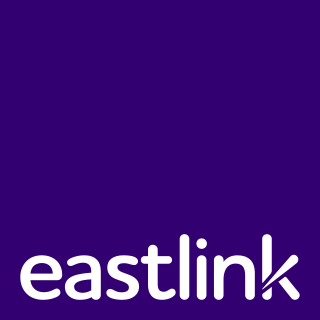
Wireless broadband is a telecommunications technology that provides high-speed wireless Internet access or computer networking access over a wide area. The term encompasses both fixed and mobile broadband.

In telecommunications, broadband or high speed is the wide-bandwidth data transmission that exploits signals at a wide spread of frequencies or several different simultaneous frequencies, and is used in fast Internet access. The transmission medium can be coaxial cable, optical fiber, wireless Internet (radio), twisted pair cable, or satellite.

Multichannel multipoint distribution service (MMDS), formerly known as broadband radio service (BRS) and also known as wireless cable, is a wireless telecommunications technology, used for general-purpose broadband networking or, more commonly, as an alternative method of cable television programming reception.
The last mile or last kilometer is a phrase widely used in the telecommunications, cable television and internet industries to refer to the final leg of the telecommunications networks that deliver telecommunication services to retail end-users (customers). More specifically, the last mile describes the portion of the telecommunications network chain that physically reaches the end-user's premises. Examples are the copper wire subscriber lines connecting landline telephones to the local telephone exchange; coaxial cable service drops carrying cable television signals from utility poles to subscribers' homes, and cell towers linking local cell phones to the cellular network. The word "mile" is used metaphorically; the length of the last mile link may be more or less than a mile. Because the last mile of a network to the user is conversely the first mile from the user's premises to the outside world when the user is sending data, the term first mile is also alternatively used.

Internet access is a facility or service that provides connectivity for a computer, a computer network, or other network device to the Internet, and for individuals or organizations to access or use applications such as email and the World Wide Web. Internet access is offered for sale by an international hierarchy of Internet service providers (ISPs) using various networking technologies. At the retail level, many organizations, including municipal entities, also provide cost-free access to the general public.

Worldwide Interoperability for Microwave Access (WiMAX) is a family of wireless broadband communication standards based on the IEEE 802.16 set of standards, which provide physical layer (PHY) and media access control (MAC) options.
4G is the fourth generation of broadband cellular network technology, succeeding 3G and preceding 5G. A 4G system must provide capabilities defined by ITU in IMT Advanced. Potential and current applications include amended mobile web access, IP telephony, gaming services, high-definition mobile TV, video conferencing, and 3D television.

Satellite Internet access is Internet access provided through communication satellites; if it can sustain high speeds, it is termed satellite broadband. Modern consumer grade satellite Internet service is typically provided to individual users through geostationary satellites that can offer relatively high data speeds, with newer satellites using the Ku band to achieve downstream data speeds up to 506 Mbit/s. In addition, new satellite internet constellations are being developed in low-earth orbit to enable low-latency internet access from space.

Evolution-Data Optimized is a telecommunications standard for the wireless transmission of data through radio signals, typically for broadband Internet access. EV-DO is an evolution of the CDMA2000 (IS-2000) standard which supports high data rates and can be deployed alongside a wireless carrier's voice services. It uses advanced multiplexing techniques including code-division multiple access (CDMA) as well as time-division multiplexing (TDM) to maximize throughput. It is a part of the CDMA2000 family of standards and has been adopted by many mobile phone service providers around the world particularly those previously employing CDMA networks. It is also used on the Globalstar satellite phone network.

Bragg Communications Inc., doing business as Eastlink, is a Canadian cable television and telecommunications company. The privately held company was founded in Nova Scotia in 1969 by the Bragg family, and has grown since through the amalgamation of several telecommunications companies.

Vislink Technologies, Inc. is an American technology company that specializes in the collection, delivery, management and distribution of high quality live video and data. Founded as xG Technology in Sarasota, Florida in 2002, the company had acquired both Vislink and Integrated Microwave Technologies by 2017. In February 2019, xG Technology formally changed its name to Vislink Technologies. The company is headquartered in Hackettstown, New Jersey and has regional offices in Billerica, Massachusetts and Anaheim, California, as well as global offices in the United Kingdom, Dubai and Singapore. Vislink is a publicly traded company listed on the NASDAQ Capital Market.
Skyriver was a business broadband Internet provider headquartered in San Diego, California. It was acquired by One Ring Networks in July, 2018. Skyriver delivered broadband Internet connectivity for enterprise and small-medium businesses, utilizing its proprietary millimeter wave technology. Skyriver offered commercial grade services including dedicated Internet access, Virtual Private Network (VPN), redundancy, and temporary Internet/event bandwidth in California.
The MVDDS dispute refers to several legal disputes and political controversies that surrounded Federal Communications Commission (FCC) approval of MVDDS terrestrial wireless broadband technology. The controversy arose over the lobbying efforts of Northpoint Technology, a developer of MVDDS, to receive approval and licensing for the technology. The dispute later transformed into several court cases against the FCC and satellite television providers, as well as a patent infringement case against MDS America and MDS International. As a result of the dispute, Northpoint lost the patents.

The Internet in the United States grew out of the ARPANET, a network sponsored by the Advanced Research Projects Agency of the U.S. Department of Defense during the 1960s. The Internet in the United States in turn provided the foundation for the worldwide Internet of today.
In telecommunications, white spaces refer to radio frequencies allocated to a broadcasting service but not used locally. National and international bodies assign frequencies for specific uses and, in most cases, license the rights to broadcast over these frequencies. This frequency allocation process creates a bandplan which for technical reasons assigns white space between used radio bands or channels to avoid interference. In this case, while the frequencies are unused, they have been specifically assigned for a purpose, such as a guard band. Most commonly however, these white spaces exist naturally between used channels, since assigning nearby transmissions to immediately adjacent channels will cause destructive interference to both.
Internet in Greece reached an 82% usage rate among individuals in 2022, yet it slightly trails behind the European Union averages in digital skills among individuals aged 16-74, as highlighted in the European Commission's Digital Decade Country Report 2023. In an effort to bridge this gap and enhance digital proficiency across the nation, Greece implemented the "Works Again" law in April 2022. This law is designed to modernize the Public Employment Service, aligning it more closely with the demands of the labor market and vocational training needs. Additionally, Greece has launched a strategic initiative for Vocational Education and Training (VET) and lifelong learning. This initiative aims to revamp educational curricula to include digital and green skills.

Tooway is a satellite broadband Internet service available across Europe. The first version of the service was launched in 2007 via two Eutelsat geostationary satellites, Hot Bird 6 and Eurobird 3, respectively at the 13° and 33° East orbital positions.
Connecting America: The National Broadband Plan is a Federal Communications Commission (FCC) plan to improve Internet access in the United States. The FCC was directed to create the plan by the American Recovery and Reinvestment Act of 2009, and unveiled its plan on March 16, 2010.
MVDDS is a type of television and Internet delivery technology licensed for use in the United States by the Federal Communications Commission (FCC). This was subsequently tested by The MITRE Corporation for the FCC. A report was filed in the 98-206 Docket before the FCC.










